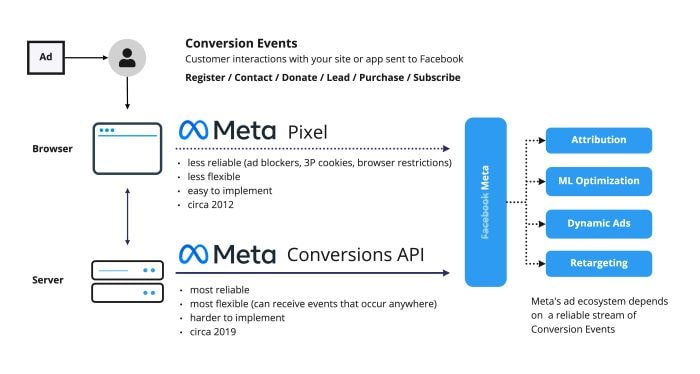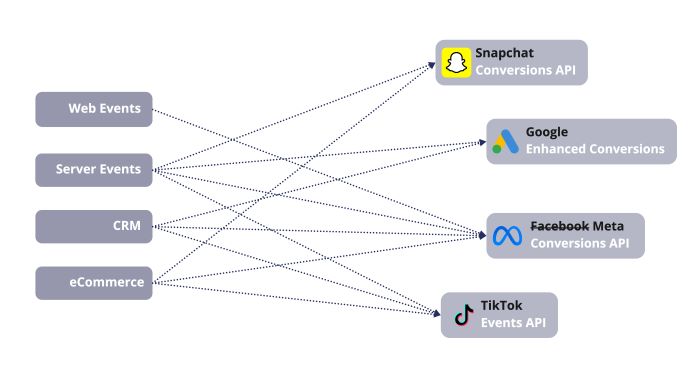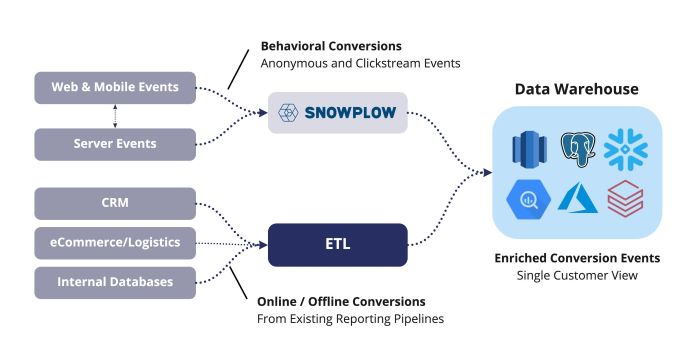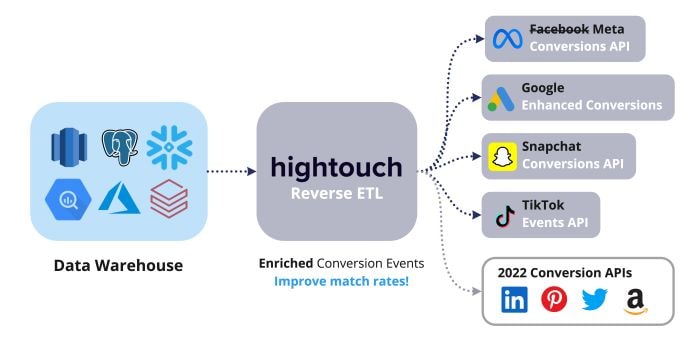Cookies Are Out, Conversions APIs are in: How to improve ROI on FB, Google & TikTok Ads

This is a guest post by Tinuiti partner, Hightouch.
Hightouch is the world’s leading Reverse ETL platform, which syncs data from data warehouses to various SaaS tools (no API integrations or scripts required). Hightouch was founded on the notion that every business team—sales, marketing, support, success—needs relevant, accurate, and real-time customer data in the software they use to talk to customers including CRM, ads, email, and support platforms. For more information, visit www.hightouch.io.
Changes in consumer privacy on the internet have dramatically altered the digital advertising ecosystem over the past several years, with even more sweeping changes on the near horizon. Conversion tracking — how a user interacts with your product — is not only essential information for ad networks, but also the most vulnerable to new browser restrictions and ad blockers, as it traditionally relies on web pixels.
In response, all of the major networks are rolling out “Conversion APIs” as a way to share events server-side, which makes them much more powerful because the integration is extremely reliable and unencumbered by browser restrictions. The downside to server-side APIs is that they’re much more time-intensive to set up than simply embedding a web pixel into your website.
Fortunately, many conversion events are readily available in your data warehouse. When combined with Reverse ETL, you can vastly reduce the level of effort to begin supporting these advertising endpoints.
In this article we’ll cover the following:
Conversion data is the lifeblood of the digital advertising ecosystem. Introduced by Facebook in 2012 with their web pixel, conversion tracking captures website interactions or browser events (ex: product views, add-to-cart, check-out, etc.). In turn, conversion data not only powers ad reporting but is also the primary engine for follow-up marketing actions, including ML audience optimization and dynamic ad targeting for potential customers.
At its core, conversion data is used to track conversions from ad platforms to optimize future ads, build custom audiences, and remarket to people who have already taken some kind of action on your website or app.
In the past, the primary way to share conversion data was through a Facebook Pixel (i.e. a web pixel), which leverages third-party cookies to share data back to Facebook directly from browser Pixel events. However, in recent years, changes in consumer privacy laws, web browsers, mobile IDs, third-party cookies, and the rise of ad blockers have all dramatically limited the ability to collect conversion data and customer actions from web pixels. In a recent article Facebook formally acknowledged the extent of this problem, estimating that it underreports iOS web conversions by approximately 15%. Knowing this, Facebook goes on to elaborate that all advertisers should turn to server-side tracking and utilize the Facebook Conversion API (Facebook CAPI) to capture lost event data as a replacement to its tracking pixel.
A Conversions API (also known as a server-side API) is similar to a web pixel, but is much more powerful because all of the data is shared server-side and managed directly by you. This conversion tracking method is more flexible because it is not limited to website interactions captured through a pixel.
Conversion APIs can receive data from offline conversions and events, or anywhere within the customer journey. Server-side conversion tracking is also much more reliable because it is unencumbered by network issues like ad blockers or tracking restrictions imposed across web browsers. For example, in the case of the Facebook Conversions API, you can choose exactly what user activity and user behavior you share with Facebook to optimize your ad spend at an extremely granular level.

Nearly every other major advertising platform has been equally affected by privacy changes, and most are introducing their own flavor of conversion APIs – Google Enhanced Conversions, SnapChat Conversions API, and TikTok Events. Even the ad platforms that do currently offer conversion APIs are working on them rapidly. In fact, Twitter and Amazon are expected to release their version of a Conversion API sometime in 2022.
The downside of server-side conversion tracking or conversion APIs lies in the time-consuming engineering tasks required to adopt them. Web pixels have an advantage in that you simply have to embed a piece of code on top of your front-end codebase.
Fortunately, the right architecture and implementation choices can drastically reduce the development effort and setup process required to improve your data quality and overall ad performance. In the remainder of this article, we’ll cover the various implementation options that lead to our two key recommendations:
In many cases, you are not just tracking interactions on your website. Event tracking is often distributed across multiple point-to-point solutions used to power your business:
Connecting multiple point solutions to conversion APIs has several disadvantages:

For reporting and analytics purposes, your data engineering team has probably already connected to many of these solutions and ingested much of this key conversion data into your warehouse. Often these key events include things like:
Starting with conversion events in your data warehouse reduces the development effort and time to value. When paired with a Reverse ETL service like Hightouch, sending conversion events is quick to implement, only taking a few hours—compared to weeks or months.
Most likely, your Marketing teams have not paused their advertising efforts, which means a high volume of conversion events cannot be associated with the corresponding campaigns. Simply put, pixel-blocking browsers and devices are affecting your campaigns today and a quick to implement solution will show an immediate return on your investment.
Aggregating conversion or event data within the data warehouse naturally results in a more complete view of the customer and associated events. The data warehouse also stores conversions that a typical web pixel cannot capture, like offline purchases and post-purchase events (product returns, loan approvals, etc.) from other ETL pipelines.
The Facebook Pixel captures 17 online conversion event types. The data warehouse contains many of the same types of events, both online and offline. On top of this, nearly all conversion APIs handle the standard events that a conventional web pixel can track.
However, top-of-funnel and anonymous events like page views and add to cart require a first-party behavioral tracking tool to be added to your site, store, or app. First-party tracking solutions are not restricted by browser blocking which affects 3rd-party tools like the Facebook Pixel.

For Behavioral Tracking, Snowplow is an excellent tool to capture behavioral events from all sources and store them in the warehouse. For example, in the context of advertising, Snowplow can capture top-of-funnel events and associate them with pseudo-anonymous clickIDs — FBCLID and GCLID — attached to your inbound links. A customer who browses and does not purchase can be re-marketed to with dynamic ads of the product viewed using just the clickID.
A complete and unified view of customer data directly correlates with improved ad performance. As detailed in Facebook’s Best Practices for Conversions API, the more customer information provided via the API the higher the associated Event Match Quality Score. A higher score increases the rate of attribution, ad delivery optimization, and drives down the cost per action.
Events match when the person interacting with your site (making a purchase) can be associated with that same user’s Facebook account. Facebook shares match rates to advertisers as an Event Match Quality Score.
Quality scores go up as more customer-identifying information is provided to the Conversions API. Customer identifiers span 18 different types, from a hashed email address, IP address, to Click ID—and the more IDs provided to Conversion APIs, the higher the quality score.
Individual point solutions only capture a subset of customer identifiers, not providing the complete picture. The data warehouse aggregates all of the data to create an enriched, single view of the customer. And when paired with a behavioral tracking solution like Snowplow, the data warehouse forms a complete view of the customer, along with the associated conversion events.
CDPs vs. Data Warehouse – Unifying customer data to improve advertising performance is one of the value propositions promoted by CDP vendors. Unfortunately, as documented elsewhere, CDPs are even more challenging to deploy, and as a result, many businesses are building the CDP on top of their data warehouse.
“To navigate a privacy-by-default world, we need new partners, different ways of thinking about tech and communication, a boatload of intelligence (data) piped into every moment—and from every channel—to wherever else an eyeball can or will engage. Keep in mind—users don’t experience channels, they experience the brand. We need new ways to use data to build those experiences, and the performance marketer of tomorrow needs to look beyond surface signals today.
So where do we look? Every time something happens in your experience, whether it’s on your website or your app, there’s data being generated. The good news is that many marketers already have these first-party and zero-party data (ZPD) signals in their data warehouse. The bad news? It’s just sitting there.
In order to unlock the value of the data warehouse, brands will need to invest in modeling (experimental design, media mix modeling, and RFM or reach, frequency, monetary modeling to name a few) to understand customer behavior, and a reverse ETL platform (hint: Hightouch) to operationalize (use) the data, audiences, and segments across any destination. A reverse ETL keeps you ready for whatever comes next.”

— Nirish Parsad, Practice Lead for Future of the Web at Tinuiti
Since implementing enriched server conversion tracking with Facebook’s Conversion API (CAPI), Red Digital partners have seen wins across the board. Within the first month of launching server-side conversions, a Red Digital partner in the mortgage industry saw a +40% lift in click conversion and a +20% increase in order volume.
Another partner in the personal finance space leveraged enriched conversion signals to build a foundation for data-led testing & optimization, which allowed them to increase spending 3x to core audiences while increasing overall Facebook profit 9x.
As one of the largest comparison businesses in Australia, Compare Club helps people make challenging financial decisions around mortgage payments, rent, loans, insurance, energy, utilities, etc. Using Hightouch to build lookalike audiences, Compare Club has reduced the cost per enquiry by as much as 9.5% for specific segments.
Two years ago, connecting the data warehouse with ad network endpoints required a significant development effort. Fortunately, the growth of the modern data stack has also given rise to Reverse ETL, which vastly simplifies the effort to activate data from the data warehouse to any number of marketing, sales, and business applications.
Reverse ETL makes it easy for you to forward data/events within your warehouse to any destination of your choosing (ex: Facebook Ads and Google Ads). All you have to do is provide access to the appropriate tables in your data warehouse, match up the columns and identifiers to each respective platform in the Hightouch UI, and schedule your data sync. On top of this, you can even build custom audiences directly within Hightouch using standard SQL or your existing data models.
Future Proofed — Hightouch supports all networks with server-side APIs today and will add support when Amazon, Twitter, LinkedIn, and Pinterest release their server-side APIs in the future.

Want to learn more about how to get started with sending data to conversion APIs? Download our step-by-step guide on how to integrate with Conversion APIs to increase Ads ROI.
